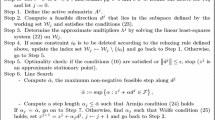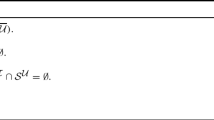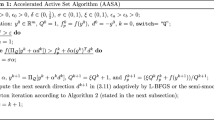Summary.
In this paper, we propose a new algorithm for solving mathematical programs with linear complementarity constraints. The algorithm uses a method of approximately active search and introduces the idea of acceptable descent face. The main advantage of the new algorithm is that it is globally convergent without requiring strong assumptions such as nondegeneracy or linear independence condition. Numerical results are presented to show the effectiveness of the algorithm.
Similar content being viewed by others
References
Harker, P.T., Pang, J.S.: On the existence of optimal solution to mathematical program with equilibrium constraints. Oper. Res. Lett. 7, 61–64 (1988)
Dempe, S.: On generalized differentiability of optimal solutions and its application to an algorithm for solving bilevel optimization problems. In: D.Z. Du, L.Q. Qi and R.S. Womersley eds., Recent Advancesin Nonsmooth Optimization, World Scientific Publishing Co., Singapore, pp. 36–56, 1995
Facchinei, F., Jiang, H., Qi, L.: A smoothing method for mathematical programs with equilibrium constraints. Math. Program. 85, 107–134 (1999)
Falk, J.E., Liu, J.: On bilevel programming, Part I: General cases. Math. Program. 70, 47–72 (1995)
Fukushima, M., Luo, Z.Q., Pang, J.S.: A globally convergent sequential quadratic programming algorithm for mathematical programs with linear complementarity constraints. Comput. Optim. Appl. 10, 5–34 (1998)
Luo, Z.Q., Pang, J.S., Ralph, D.: Piece-wise sequential quadratic programming for mathematical Programs with nonlinear complementarity constraints. In: M.C. Ferris and J.S. Pang, eds., Complementarity and Variational Problems: State of the Art, SIAM Publications, 1997
Outrata, J., Zowe, J.: A numerical approach to optimization problems with variational inequality constraints. Math. Program. 68, 105–130 (1995)
Pang, J.S., Fukushima, M.: Complementarity constraint qualifications and simplified B-stationary conditions for mathematical programs with equilibrium constraints. Comput. Optim. Appl. 13, 111–136 (1999)
Ralph, D.: Sequential quadratic programming for mathematical programs with linear complementarity constraints. In: R.L. May and A.K. Easton eds., CTAC95 Computational Techniques and Applications, World Scientific, 1996
Scholtes, S., Stöhr, M.: Exact penalization of mathematical programs with equilibrium constraints. SIAM J. Cont. Optim. 37, 617–652 (1999)
Vicente, L., Savard, G., Judice, J.: Descent approaches for quadratic bilevel programming. J. Optim. Theory Appl. 81, 379–399 (1994)
Zhang, J.Z., Liu, G.S.: A new extreme point algorithm and its application in PSQP algorithms for solving mathematical programs with linear Complementarity constraints. J. Global Optim. 19, 345–361 (2001)
Marcotte, P., Zhu, D.L.: Exact and inexact penalty methods for the generalized bilevel programming problems. Math. Program. 74, 141–157 (1996)
Ye, J., Zhu, D., Zhu, Q.: Generalized bilevel programming problems. SIAM J. Optim. 7, 481–507 (1997)
Anandalingam, G., Friesz, T. (eds.): Hierarchical optimization. Ann. Oper. Res. 34, (1992)
Luo, Z.Q., Pang, J.S., Ralph, D.: Mathematical Programs with Equilibrium Constraints. Cambridge University Press, Cambridge, 1996
Migdalas, A., Pardalos, P.M. (eds.): Hierarchical and bilevel programming. J. Global Optim. 8, (1996)
Vicente, L.N., Calamai, P.H.: Bilevel and multilevel programming: A bibliography review. J. Global Optim. 3, 291–306 (1994)
Scholtes, S.: Active set method for inverse linear complementarity problems. Technique Report, Department of Engineering and Judge Institut of Management Studies, University of Cambridge, Cambridge CB2 1AG, England
Fukushima, M., Tseng, P.: An implementable active-set algorithm for computing a B-stationary point of a mathematical programs with linear complementarity constraints. SIAM J. Optim. 12(3), 724–739 (2002)
Jiang, H.Y., Ralph, D.: QPECgen, a MATLAB Generator for Mathematical Programs with Quadratic Objectives and Affine Variational Inequality Constraints. Comput. Optim. Appl. 13, 25–59 (1999)
Fiacco, A.V.: Introduction to Sensitivity and Stability Analysis in Nonlinear Programming. Academic Press, New York, 1983
Author information
Authors and Affiliations
Additional information
Mathematics Subject Classification (2000): 90C30, 90C33, 65K05
This research is partially supported by City University of Hong Kong under its Strategic Research Grant #7001339 and the National Natural Science Foundation of China grant # 10171108 and # 70271014
Rights and permissions
About this article
Cite this article
Zhang, J., Liu, G. & Wang, S. A globally convergent approximately active search algorithm for solving mathematical programs with linear complementarity constraints. Numer. Math. 98, 539–558 (2004). https://doi.org/10.1007/s00211-004-0542-9
Received:
Published:
Issue Date:
DOI: https://doi.org/10.1007/s00211-004-0542-9




